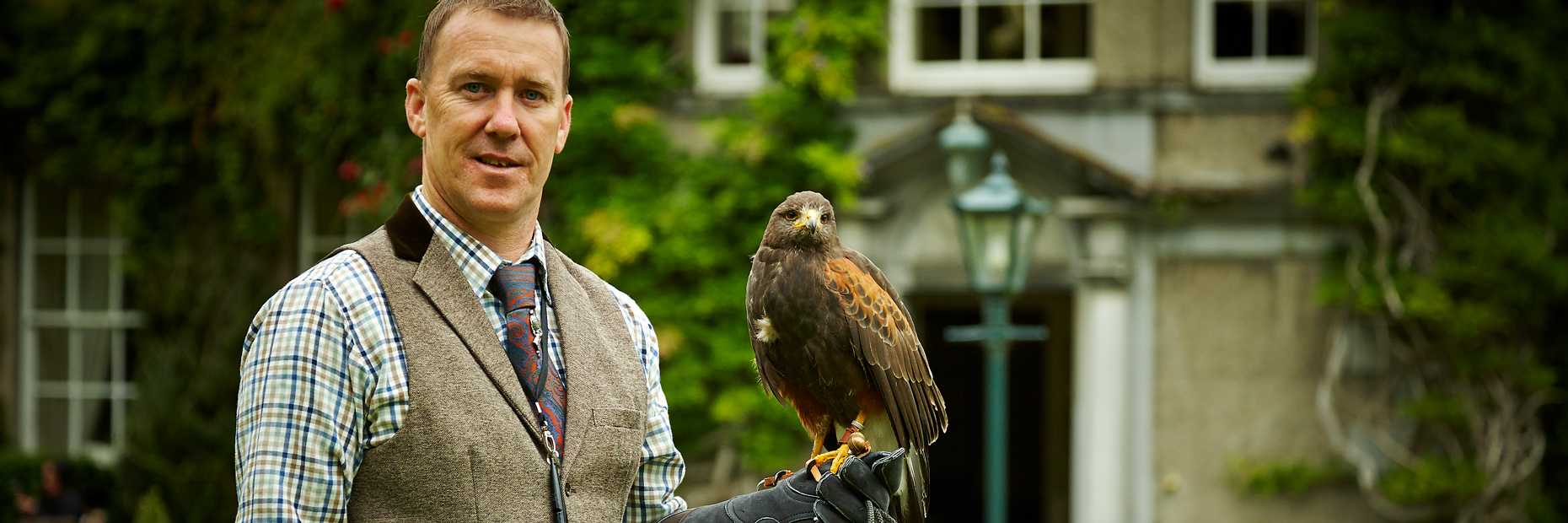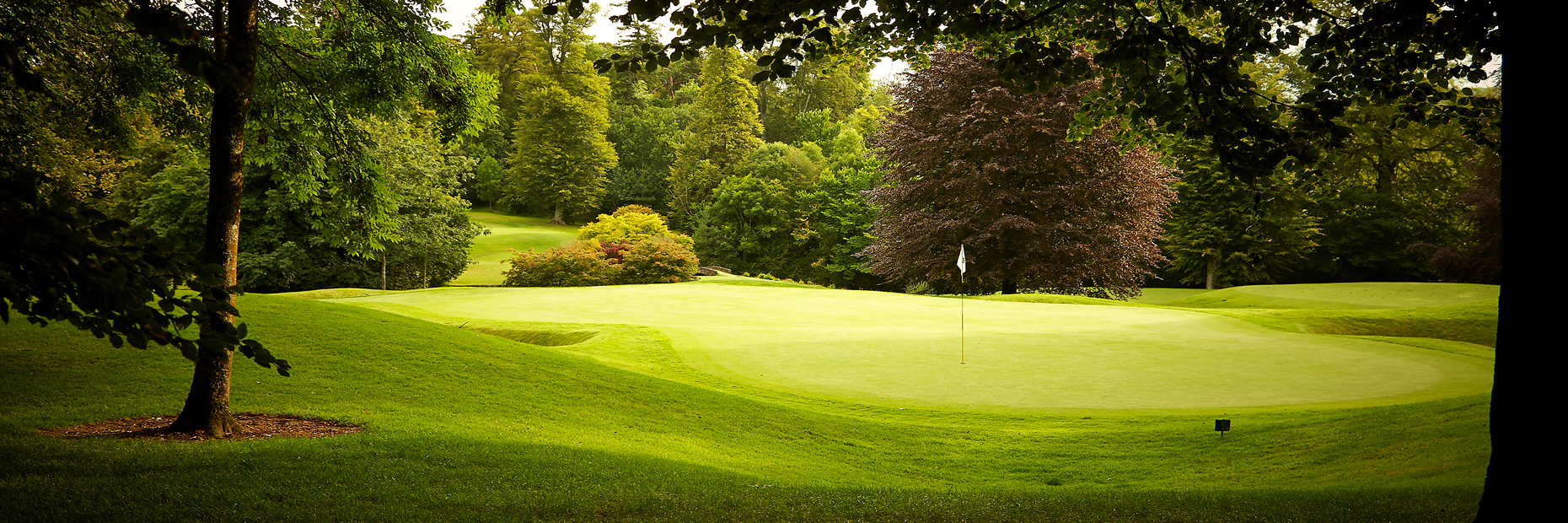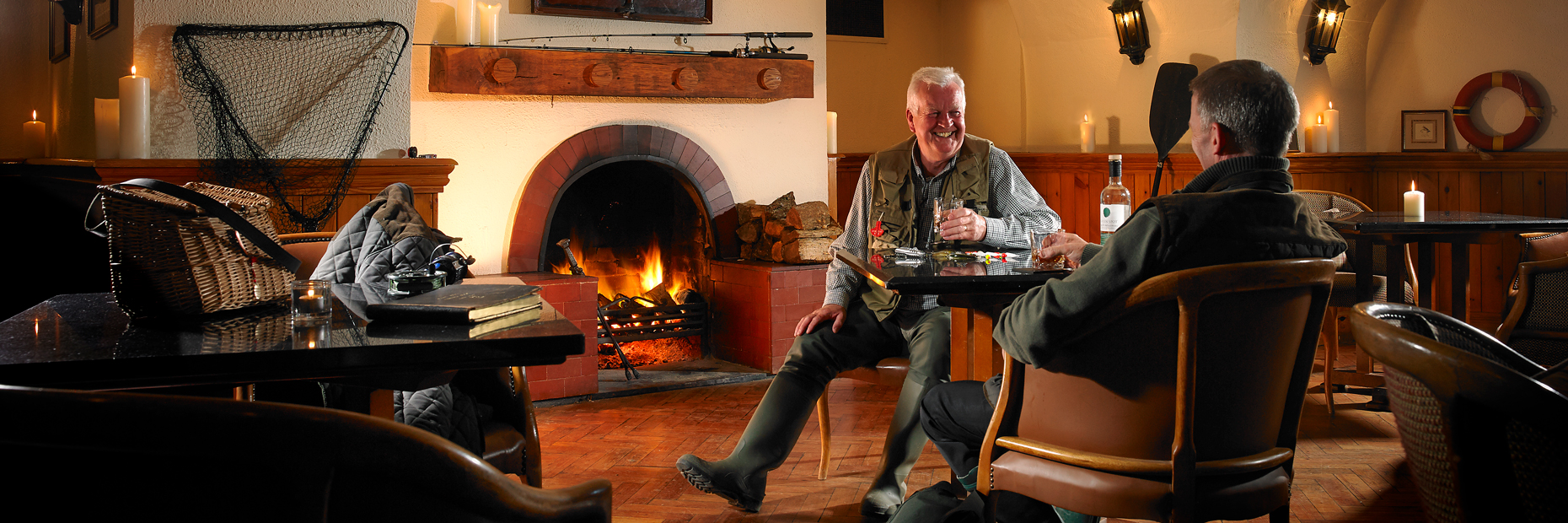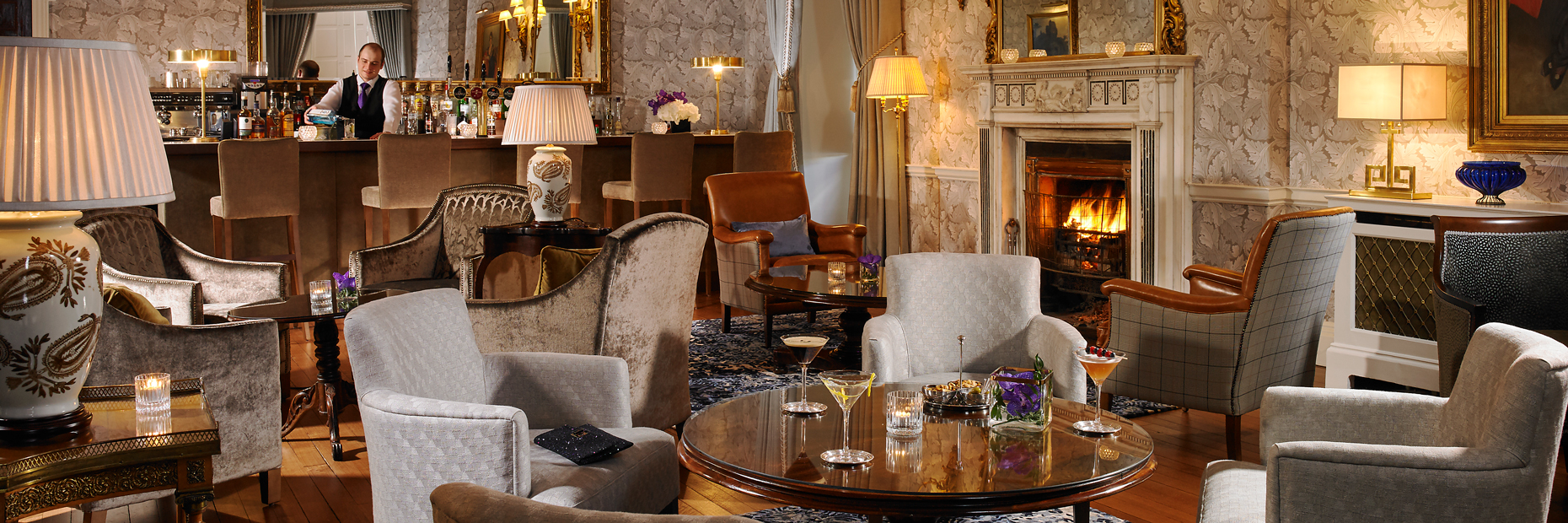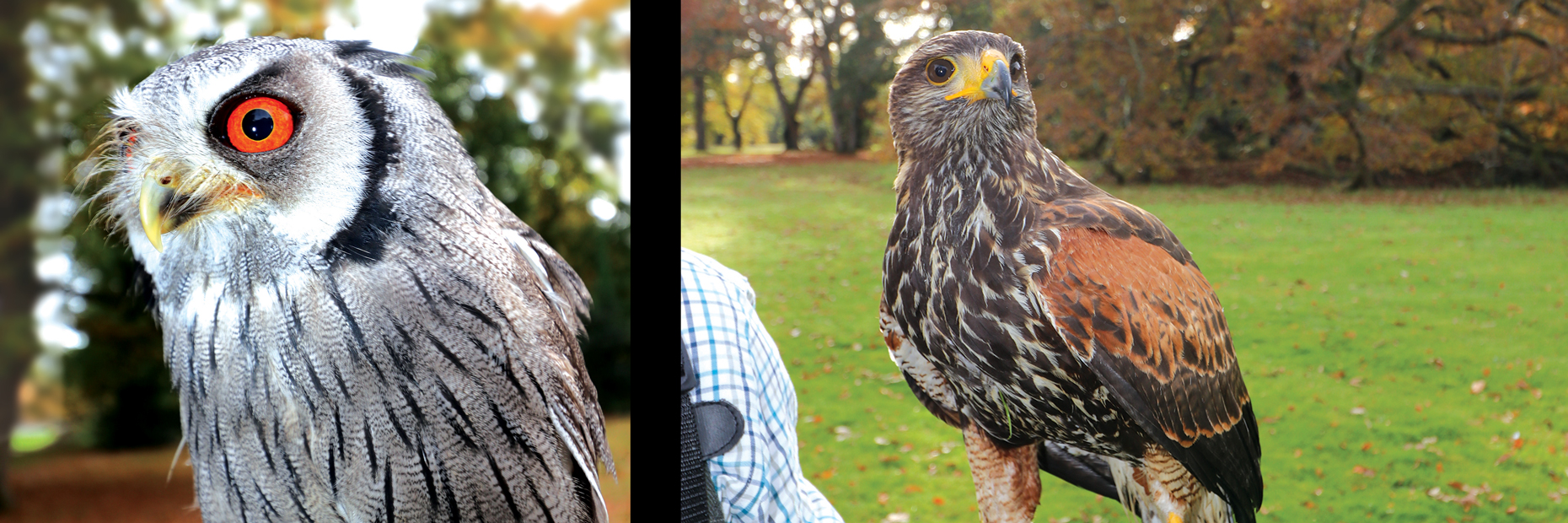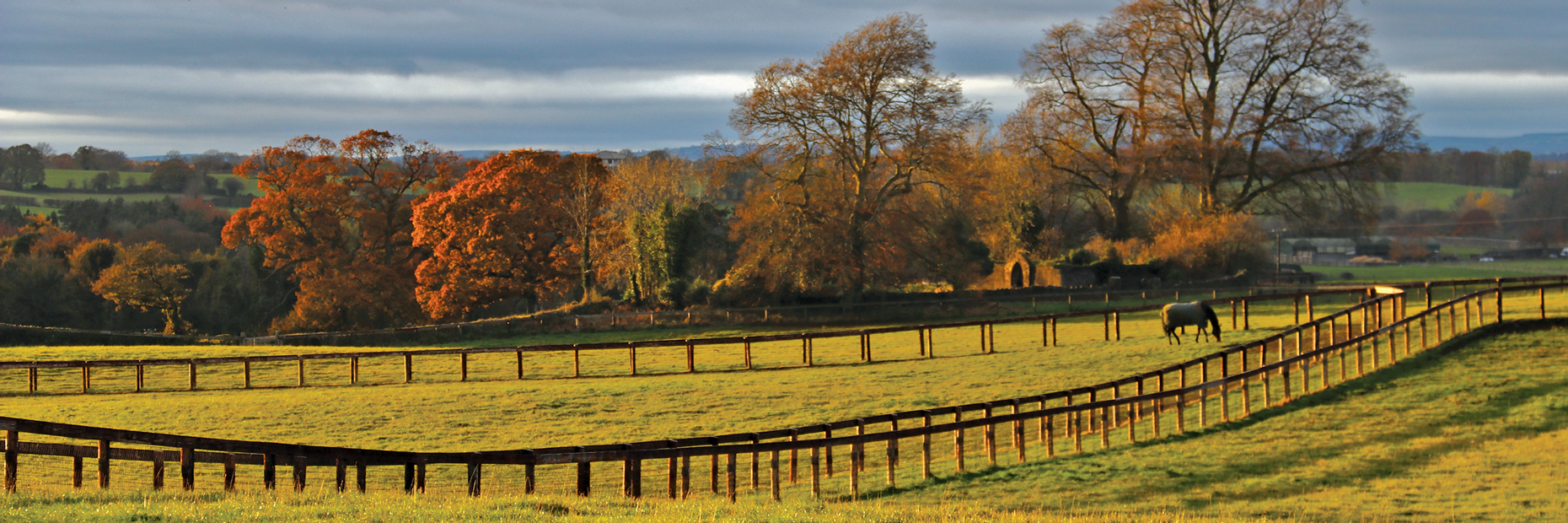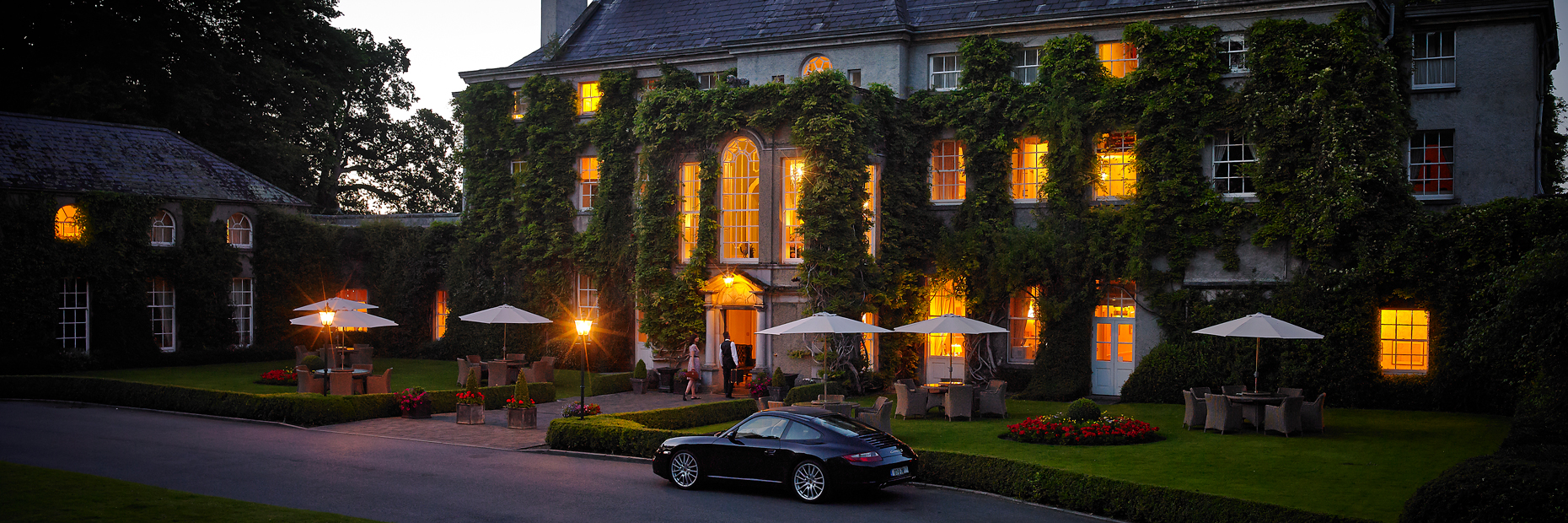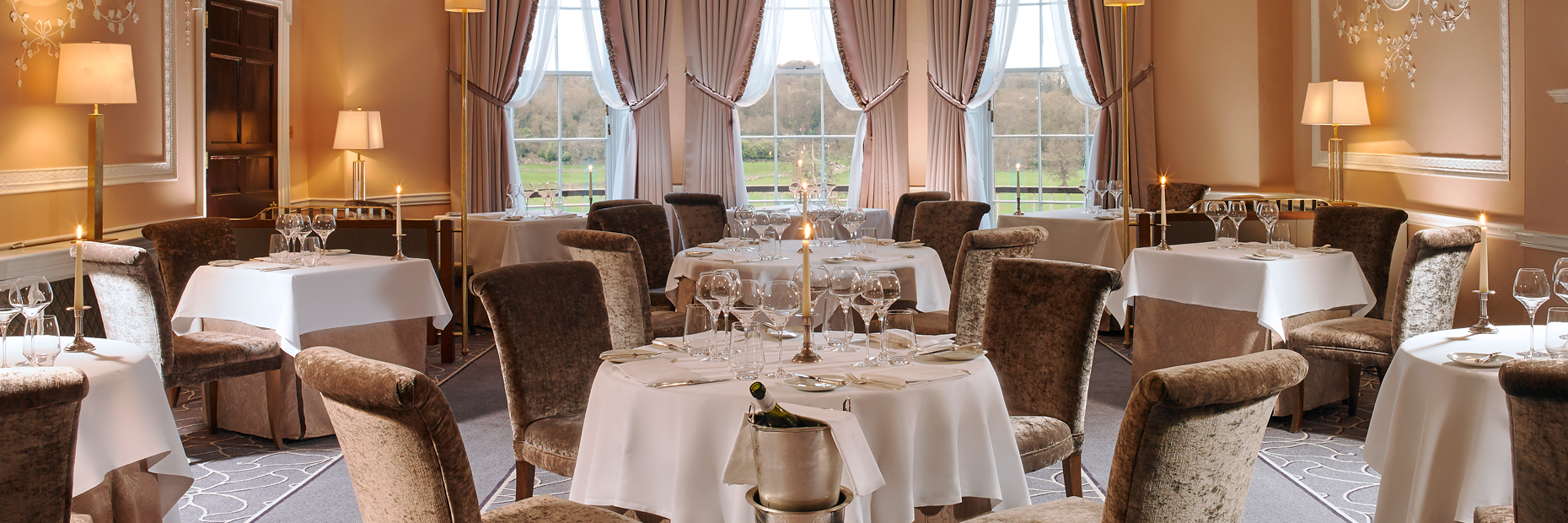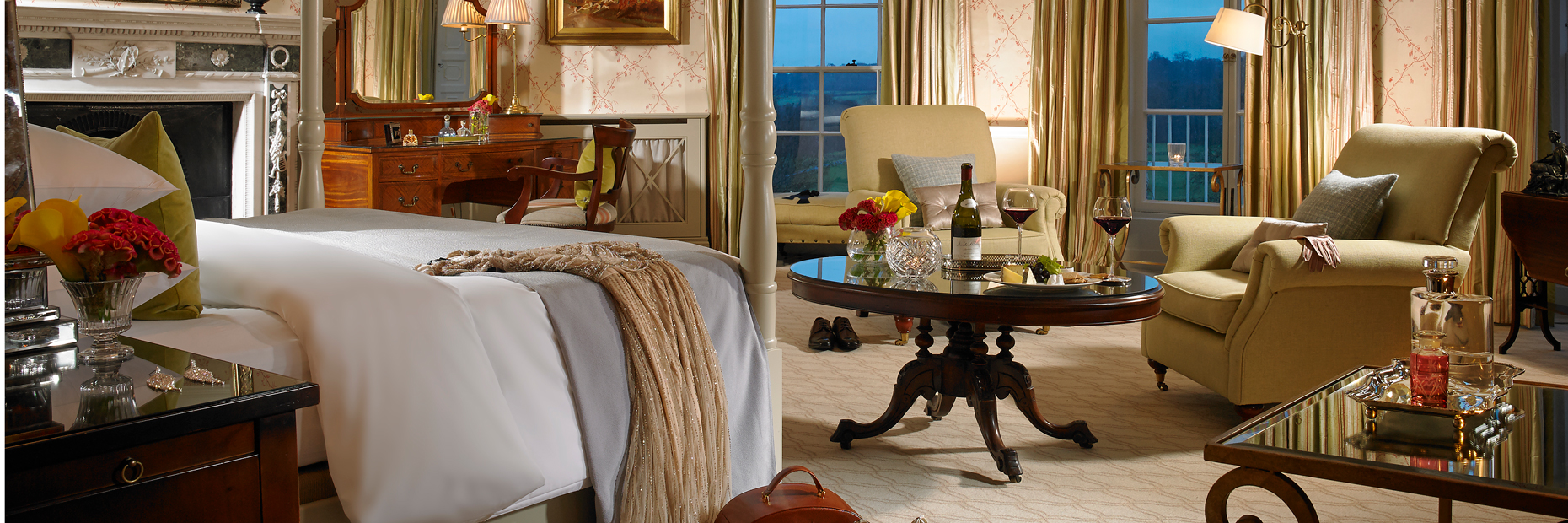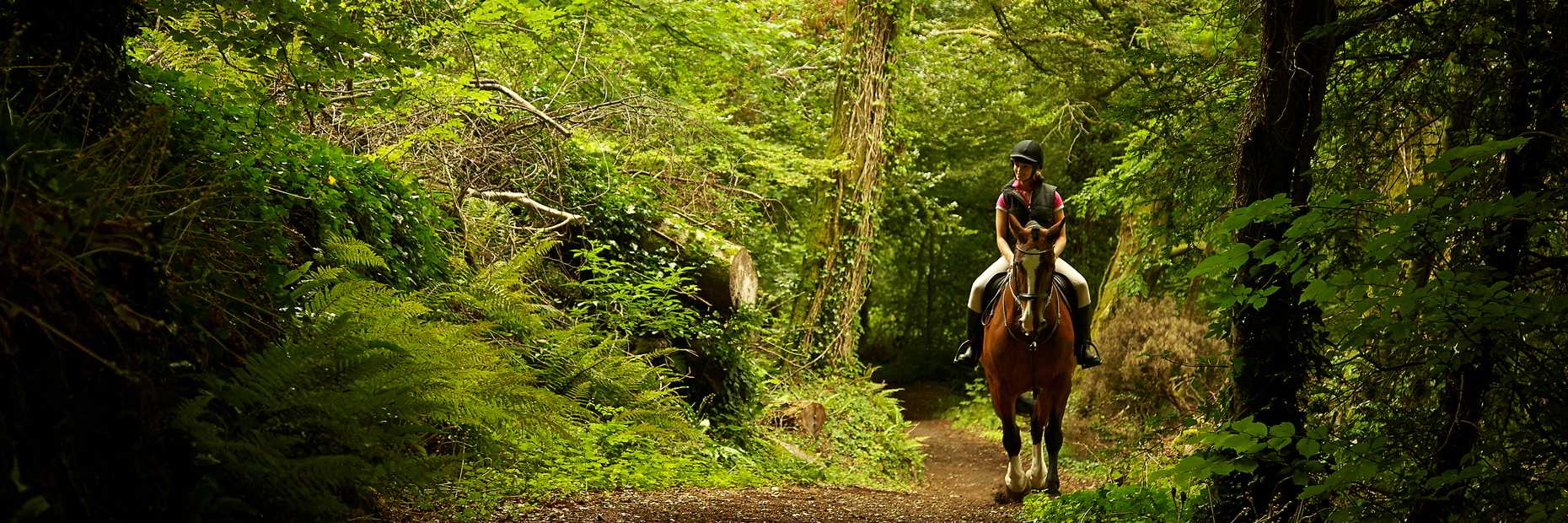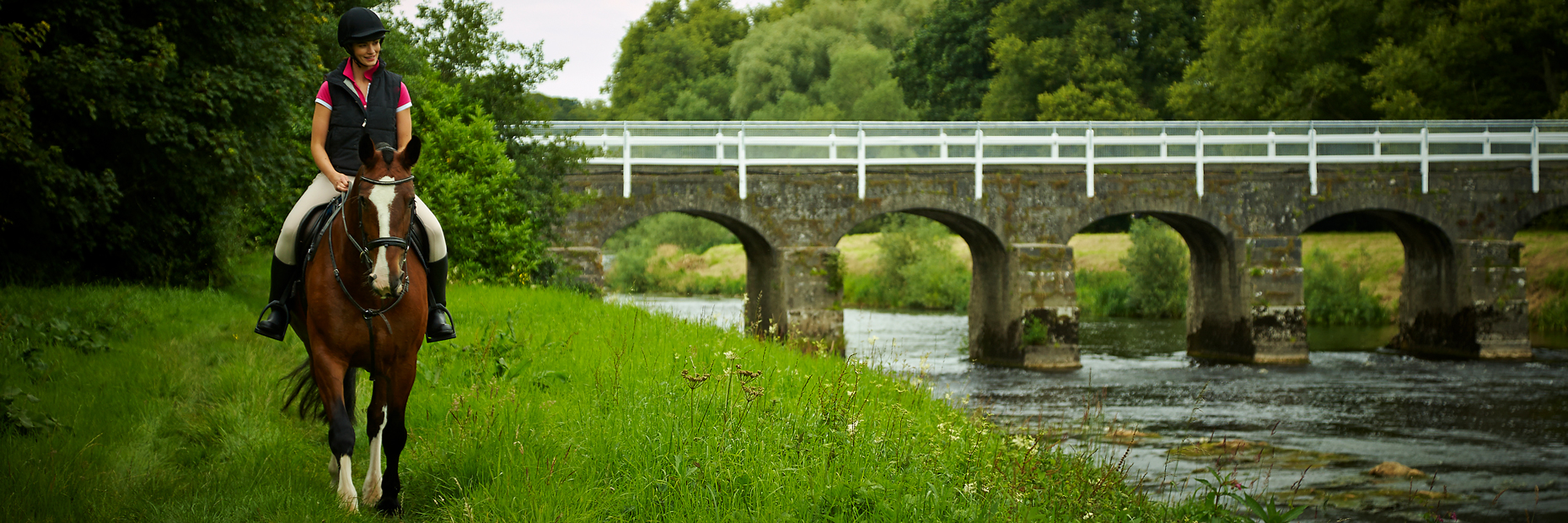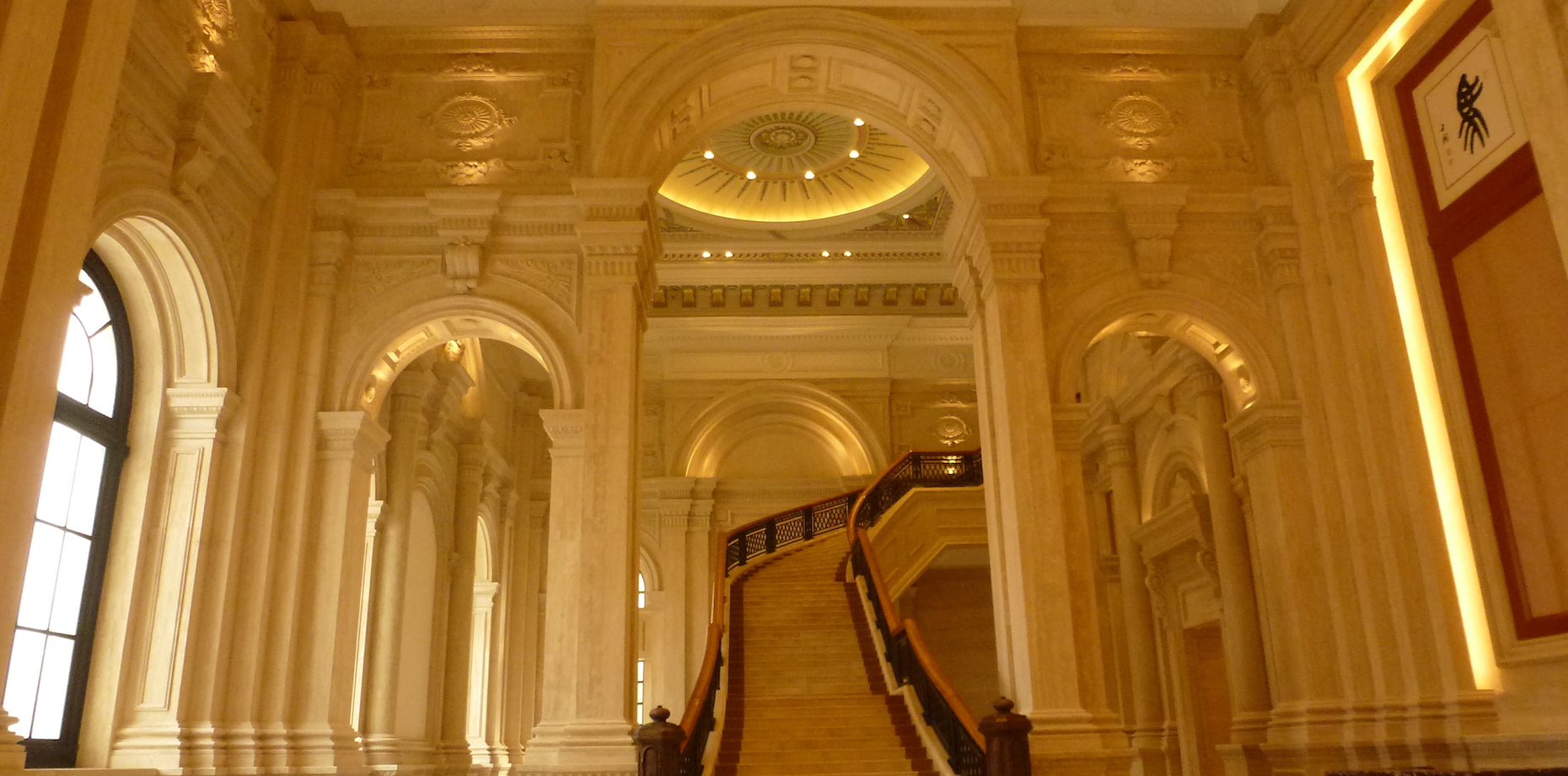An Irish Travel Diary.
This 18th-century estate in Kilkenny, Ireland offers the charms of a bygone era, and includes all the exhilarating country pursuits you can
shake a silver-headed walking stick at.
I don’t want to ride. My friend gapes at me in disbelief. Never in the 10 years of our association has he heard me utter such blasphemy. He asks if I am unwell.
I am not unwell. Quite the contrary. I’m seated in the Michelin-starred Lady Helen restaurant at Mount Juliet, a stunning country estate in County Kilkenny, Ireland. I’m meant to ride around the estate at 10 a.m., but I’m loath to leave the restful elegance of the dining room. The walls are painted a gentle peach, accented with white bas-relief medallions and decorative molding, while the white linen tablecloths are impeccably starched, and the chairs are upholstered in understated taupe velvet. It’s a room designed to soothe the senses.
Our table offers an incomparable view; the River Nore ambles along between gentle green banks as the morning mist rises from the meadows beyond. In the distance, a forest blazes with autumn color. The landscape begs for an unhurried hour passed in quiet contemplation. If only this were my estate, I could linger to give this view the full measure of respect it deserves.
Lamentably, the schedule does not permit gentle reflection, and the 1,500-acre Mount Juliet estate is not mine. Rather, it is one of the great historic estates of Europe and perhaps the most stunning country-house hotel in Ireland. The estate offers the charms of a bygone era, and that includes all the exhilarating country pursuits you can shake a silver-headed walking stick at.
Mount Juliet combines two historic properties, Walton’s Grove and Ballylinch. Old Norman families originally occupied both, until Oliver Cromwell seized the land in 1653, following the English Civil War. Walton’s Grove was briefly owned by the Duke of York and subsequently passed through several hands until its sale to the Earl of Carrick in 1757.
Cromwell granted Ballylinch to a supporter in 1654, and it was his daughter’s marriage that brought the estate into the Butler family. Somerset Hamilton Butler, the First Earl of Carrick, purchased Walton’s Grove and in the mid-18th century built the Georgian mansion that graces the estate today. He named it Mount Juliet as a compliment to his wife, the Lady Juliana.
This history had been on my mind since I arrived the previous night, after a harrowing moonlit journey through narrow country lanes and looming hedgerows in a manual transmission car with a right-hand drive. Idyllic pastoral beauty has its price. My long-suffering friend, his stiff upper lip slightly less so after several near misses, made for the Major’s Bar while I handled the formalities. Then, I found him relaxed, seated in a deep armchair before a cozy fire, crystal glass of Irish whiskey clutched firmly in hand.
The bar boasted an impressive cocktail menu, clutches of overstuffed armchairs and sofas arranged around gleaming antique tables, walls hung with hunting pictures and equestrian memorabilia, and portraits of several militarily attired gentlemen I could only presume to be the majors themselves. I later discovered that the portraits were indeed the venerable officers for whom the bar was named: Major-General Sir Hugh McCalmont and Major Dermot McCalmont, both representatives of the family that owned Mount Juliet from 1914 until it was sold to the current owners.
I was wildly overstimulated by Mount Juliet’s sheer country-house perfection. It played into every fantasy to which a certain type of Jane Austen-, Downton Abbey-loving American woman is vulnerable. Nonetheless, the cocktails, the comfort of the canopied bed, and the room’s restful gold and beige décor assured a sound and dreamless sleep.
Despite my desire to spend the rest of my life in the Lady Helen dining room, I was raring to go when I arrived at the Mount Juliet equestrian center. The director, Jacqueline Malone, was already astride a splendid chestnut gelding. He was a prancing, spinning handful, but Malone was nonplussed as he danced across the stableyard. She demanded to know why my friend was not along. “He doesn’t ride,” I admitted apologetically.
“Oh dear,” she grimaced. “Well, we’ll call him when we’re close to the house. He’s not missing this!”
Sinead, one of the center’s instructors, led my mount, a white behemoth named Junior, forward. The equestrian center offers not only hacking across the estate, but basic tuition, cross-country jumping, and show jumping. Since it was half-term in Ireland, Mount Juliet was conducting a children’s equestrian camp; children ride throughout the day while parents enjoy the vast amenities the estate has to offer.
We set off, and Jacqueline pointed out Mount Juliet’s Jack Nicklaus signature 18-hole golf course, which has hosted a number of prestigious tournaments, including the Murphy’s Irish Open. “Hmph, if you like that sort thing,” I huffed. Of course, a great many do, and the presence of such a magnificent golf course, as well as an 18-hole, par-53 putting course and extensive practice facilities, is one way to keep those non-riding companions entertained. Along with myriad golfing opportunities (there are also 8 other golf courses in a 50-mile radius), the estate offers salmon and trout fishing, sporting-clay shooting, archery, and falconry. Tuition and equipment are provided for all sports, so pack those Barbours and wellies and tweeds.
But if tweed is too scratchy and shotguns too thundering, fear not. Mount Juliet offers a host of activities for the more delicately inclined as well. The estate’s leisure center and spa boasts a 15-meter heated swimming pool, a sauna, steam room, full gym, and a beauty salon where you can get buffed, puffed, polished, and massaged. One should be at one’s resplendent best for dinner with Lady Helen.
The ride around the estate took a full two hours; we trotted down forested trails, saw salmon splash as we strolled aside the River Nore, and looked longingly across the banks to the verdant pastures of the Ballylinch Stud Farm. Although riding on the stud is prohibited, guests are welcome to stroll across the footbridge and befriend the yearlings grazing near the river. Circumstances permitting, a tour of the stud farm can be arranged.
Once we neared the manor house, Jacqueline commandeered my phone and ordered my friend downstairs at once. There’s nothing like riding up to an ivy-covered Georgian mansion on horseback to make you feel like a member of the landed gentry. I heartily recommend it. My friend was cajoled into a cautious meeting with Junior, who nuzzled his pocket for treats. Once we made our way back to the stable, we leapt into Jacqueline’s Range Rover for the next adventure. It was time for us to meet John Duggan, from Hawkeye Falconry.
The hands-on falconry demonstration was the hands-down highlight of an incredible stay. Duggan delivered an informative lecture on training birds of prey before he pulled on a sturdy leather glove and retrieved Stewart from the back of his van. Stewart, a Harris hawk, gave us the gimlet eye and uttered a series of shrill squawks. No cause to be alarmed, John assured us. Jacqueline, my friend, and I gathered around as Duggan explained the hawk’s capabilities. Stewart stood silently, his eyes fixed on John. He knew what was coming.
John released the bird and hurled a hunk of raw chicken high into the air. Stewart swooped and swallowed, then assumed a perch high in a tree some 50 yards away. John produced what appeared to be a furry tail and began to run, dragging the tail behind him. Stewart dived on silent wings, delivering death from the sky.
Now it was my turn. John released Stewart, who returned to his tree. I pulled on the stiff leather glove and John balanced a piece of raw chicken on my outstretched hand. Stewart headed straight for me at blazing speed. I tensed, waiting for the impact. He was surprisingly light and perched daintily on my hand, the scrap of chicken hanging from his beak. He tossed his head and swallowed in a gulp, then gave another high-pitched scream of pleasure. Once everyone had a go, Stewart was returned to his traveling box. The next avian guest appeared: a small gray owl named Margaret with eyes the color of an artificially flavored Halloween candy. She chortled and clucked, perching on our hands as we cooed in delight.
The falconry experience can be tailored according to preference—watch the hawks fly, or sign up for a more extensive hunting experience. Whatever the choice, flying a magnificent bird of prey is an experience you’ll never forget.
Of course, all of these wholesome country pursuits whet the appetite, and Mount Juliet has dining options for every taste. The Major’s Bar is a great choice for lunch, and the steak sandwich, razored slivers of juicy beef dripping onto crisp white toast, was a filling choice after the rigors of the morning. When it came to dinner, the Lady Helen was sadly closed on Tuesdays, so we dined at The Hound, the estate’s more informal restaurant. Of course, informal is a relative term. Open beams, a hardwood floor, and multitudinous windows combine with floral-upholstered armchairs to create an ambience simultaneously cozy and sophisticated. The cooking is inventive and assured. We shared a salad of roasted figs, arugula, and goat cheese with caramelized walnuts. A main course of risotto with smoky chunks of pancetta was creamy and comforting, while my friend’s crab tart was sweet and clean. The wine list is extensive, with plenty of reasonably priced options; our waiter suggested a chardonnay that paired perfectly with the meal.
Mount Juliet offered everything my heart could desire in a dream holiday—plenty of horseback riding, beautiful countryside, an excuse to dress up in tweed costumes like a pretentious git, Michelin-star dining, and a cozy bar for a restorative tipple after a hard day of country revelry. Even my die-hard urbanite friend left ready to buy a pair of Purdey’s and a tweed cap. I’ll be making another reservation this fall—just not during half-term.
CAPTIONS
John Duggan from the estate’s Hawkeye Falconry.
Margaret, a striking, small grey owl. Stewart, a Harris Hawk.
The Major’s Bar offers roaring fires, overstuffed chairs, and an impressive cocktail menu.
The Jinks Bar is the favored spot to relax after a day of fishing on the estate.
One of the estate’s guest rooms with a canopy bed, a fireplace, and a soothing
palette of beige and gold.
The elegant main entrance of Mount Juliet showcases displays of ornate bas relief
The lush yearling
paddocks of Ballylinch Stud Farm.
Guests are welcome to stroll across the footbridge and befriend the
yearlings grazing near the river.
A breathtaking view of Mount Juliet from Ballylinch Stud
A relaxing day’s hack along the River Nore.
The Michelin-starred Lady Helen restaurant at the estate is a room designed to soothe the senses.
The estate’s Jack Nicklaus signature 18-hole golf course is host to a number of prestigious tournaments.
Casual hacks through the property feature scenic views of the River Nore and rides by the ivy-covered Georgian mansion.

